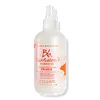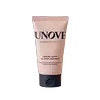What's inside
What's inside
 Key Ingredients
Key Ingredients

 Benefits
Benefits

 Concerns
Concerns

 Ingredients Side-by-side
Ingredients Side-by-side

Water
Skin ConditioningCetearyl Alcohol
EmollientButylene Glycol
HumectantPEG-12 Glyceryl Dimyristate
Skin ConditioningVitis Vinifera Seed Oil
EmollientPrunus Amygdalus Dulcis Oil
Skin ConditioningMacadamia Integrifolia Seed Oil
Skin ConditioningCocos Nucifera Oil
MaskingGardenia Taitensis Flower Extract
Skin ConditioningArgania Spinosa Kernel Oil
EmollientCarthamus Tinctorius Seed Oil
MaskingHydroxypropyltrimonium Hydrolyzed Corn Starch
Hydrolyzed Vegetable Protein Pg-Propyl Silanetriol
Skin ConditioningHydrolyzed Wheat Protein Pg-Propyl Silanetriol
Skin ConditioningDimethicone
EmollientGlycerin
HumectantSodium Hyaluronate
HumectantBehentrimonium Methosulfate
Distearyldimonium Chloride
Dimethiconol
EmollientCetrimonium Chloride
AntimicrobialButyl Methoxydibenzoylmethane
UV AbsorberEthylhexyl Methoxycinnamate
UV AbsorberSodium Chloride
MaskingCitric Acid
BufferingBHT
AntioxidantParfum
MaskingHexyl Cinnamal
PerfumingLinalool
PerfumingLimonene
PerfumingPotassium Sorbate
PreservativePhenoxyethanol
PreservativeWater, Cetearyl Alcohol, Butylene Glycol, PEG-12 Glyceryl Dimyristate, Vitis Vinifera Seed Oil, Prunus Amygdalus Dulcis Oil, Macadamia Integrifolia Seed Oil, Cocos Nucifera Oil, Gardenia Taitensis Flower Extract, Argania Spinosa Kernel Oil, Carthamus Tinctorius Seed Oil, Hydroxypropyltrimonium Hydrolyzed Corn Starch, Hydrolyzed Vegetable Protein Pg-Propyl Silanetriol, Hydrolyzed Wheat Protein Pg-Propyl Silanetriol, Dimethicone, Glycerin, Sodium Hyaluronate, Behentrimonium Methosulfate, Distearyldimonium Chloride, Dimethiconol, Cetrimonium Chloride, Butyl Methoxydibenzoylmethane, Ethylhexyl Methoxycinnamate, Sodium Chloride, Citric Acid, BHT, Parfum, Hexyl Cinnamal, Linalool, Limonene, Potassium Sorbate, Phenoxyethanol
Glycerin
HumectantWater
Skin ConditioningDimethicone
EmollientMyristyl Alcohol
EmollientCamellia Japonica Seed Oil
EmollientSteartrimonium Chloride
PreservativeParfum
MaskingPropylene Glycol
HumectantDipropylene Glycol
HumectantCaprylyl Glycol
EmollientTocopheryl Acetate
AntioxidantHydroxyacetophenone
AntioxidantHexyl Cinnamal
PerfumingC12-15 Pareth-3
EmulsifyingGuar Hydroxypropyltrimonium Chloride
Skin ConditioningDisodium EDTA
Cocamidopropyl Betaine
CleansingPhenoxyethanol
PreservativePolyquaternium-7
Salicylic Acid
MaskingGeraniol
PerfumingCitronellol
PerfumingLimonene
PerfumingSodium Hydroxide
BufferingSodium Benzoate
MaskingHydrolyzed Keratin
HumectantAlpha-Isomethyl Ionone
PerfumingArgania Spinosa Kernel Oil
EmollientOlea Europaea Fruit Oil
MaskingMacadamia Integrifolia Seed Oil
Skin ConditioningHelianthus Annuus Seed Oil
EmollientHydrolyzed Milk Protein
Skin ConditioningHydrolyzed Collagen
EmollientHydrolyzed Silk
HumectantButylene Glycol
Humectant1,2-Hexanediol
Skin ConditioningCysteine
AntioxidantSilk Amino Acids
HumectantEthyl Hexanediol
SolventEthylhexylglycerin
Skin ConditioningHydrolyzed Corn Protein
Skin ConditioningHydrolyzed Wheat Protein
Skin ConditioningHydrolyzed Soy Protein
HumectantLeucine
Skin ConditioningValine
MaskingIsoleucine
Skin ConditioningTaurine
BufferingAspartic Acid
MaskingOrnithine
Skin ConditioningGlutamic Acid
HumectantGlycine
BufferingGlutamine
Skin ConditioningLysine
Skin ConditioningMethionine
Skin ConditioningSerine
MaskingCystine
MaskingAsparagine
MaskingAlanine
MaskingArginine
MaskingTyrosine
MaskingThreonine
Tryptophan
MaskingPhenylalanine
MaskingProline
Skin ConditioningHistidine
HumectantGlycerin, Water, Dimethicone, Myristyl Alcohol, Camellia Japonica Seed Oil, Steartrimonium Chloride, Parfum, Propylene Glycol, Dipropylene Glycol, Caprylyl Glycol, Tocopheryl Acetate, Hydroxyacetophenone, Hexyl Cinnamal, C12-15 Pareth-3, Guar Hydroxypropyltrimonium Chloride, Disodium EDTA, Cocamidopropyl Betaine, Phenoxyethanol, Polyquaternium-7, Salicylic Acid, Geraniol, Citronellol, Limonene, Sodium Hydroxide, Sodium Benzoate, Hydrolyzed Keratin, Alpha-Isomethyl Ionone, Argania Spinosa Kernel Oil, Olea Europaea Fruit Oil, Macadamia Integrifolia Seed Oil, Helianthus Annuus Seed Oil, Hydrolyzed Milk Protein, Hydrolyzed Collagen, Hydrolyzed Silk, Butylene Glycol, 1,2-Hexanediol, Cysteine, Silk Amino Acids, Ethyl Hexanediol, Ethylhexylglycerin, Hydrolyzed Corn Protein, Hydrolyzed Wheat Protein, Hydrolyzed Soy Protein, Leucine, Valine, Isoleucine, Taurine, Aspartic Acid, Ornithine, Glutamic Acid, Glycine, Glutamine, Lysine, Methionine, Serine, Cystine, Asparagine, Alanine, Arginine, Tyrosine, Threonine, Tryptophan, Phenylalanine, Proline, Histidine
 Reviews
Reviews

Ingredients Explained
These ingredients are found in both products.
Ingredients higher up in an ingredient list are typically present in a larger amount.
You may know this ingredient as argan oil. Argan Oil has antioxidant, hydrating, and soothing properties.
Studies have shown argan oil can help fight again radical damage from the sun. This makes it effective at preventing hyperpigmentation.
Large amounts of vitamin E found in argan oil helps the skin retain water. Argan oil also contains fatty acids such as linoleic acid, oleic acid, and palmitic acid. It is also a good source of lipids.
Another benefit of argan oil is skin-soothing. It can help reduce inflammation-related skin symptoms.
Argan Oil is effective at regulating sebum production in pores. This can make it effective at treating hormonal acne.
Traditionally, argan oil was used for its antibacterial and antifungal properties. However, argan oil contains fatty acids that may make it not fungal-acne safe.
Argan Trees are native to Morocco.
Learn more about Argania Spinosa Kernel OilButylene Glycol (or BG) is used within cosmetic products for a few different reasons:
Overall, Butylene Glycol is a safe and well-rounded ingredient that works well with other ingredients.
Though this ingredient works well with most skin types, some people with sensitive skin may experience a reaction such as allergic rashes, closed comedones, or itchiness.
Learn more about Butylene GlycolDimethicone is a type of synthetic silicone created from natural materials such as quartz.
What it does:
Dimethicone comes in different viscosities:
Depending on the viscosity, dimethicone has different properties.
Ingredients lists don't always show which type is used, so we recommend reaching out to the brand if you have questions about the viscosity.
This ingredient is unlikely to cause irritation because it does not get absorbed into skin. However, people with silicone allergies should be careful about using this ingredient.
Note: Dimethicone may contribute to pilling. This is because it is not oil or water soluble, so pilling may occur when layered with products. When mixed with heavy oils in a formula, the outcome is also quite greasy.
Learn more about DimethiconeGlycerin is already naturally found in your skin. It helps moisturize and protect your skin.
A study from 2016 found glycerin to be more effective as a humectant than AHAs and hyaluronic acid.
As a humectant, it helps the skin stay hydrated by pulling moisture to your skin. The low molecular weight of glycerin allows it to pull moisture into the deeper layers of your skin.
Hydrated skin improves your skin barrier; Your skin barrier helps protect against irritants and bacteria.
Glycerin has also been found to have antimicrobial and antiviral properties. Due to these properties, glycerin is often used in wound and burn treatments.
In cosmetics, glycerin is usually derived from plants such as soybean or palm. However, it can also be sourced from animals, such as tallow or animal fat.
This ingredient is organic, colorless, odorless, and non-toxic.
Glycerin is the name for this ingredient in American English. British English uses Glycerol/Glycerine.
Learn more about GlycerinHexyl Cinnamal is a fragrance ingredient with a similar scent to jasmine. It can be naturally found in chamomile essential oil.
This ingredient is a known EU allergen and may sensitize the skin. The EU requires this ingredient to be listed separately on an ingredients list.
Hexyl Cinnamal is not water soluble but is soluble in oils.
Learn more about Hexyl CinnamalLimonene is a fragrance that adds scent and taste to a formulation.
It's found in the peel oil of citrus fruits and other plants such as lavender and eucalyptus. The scent of limonene is generally described as "sweet citrus".
Limonene acts as an antioxidant, meaning it helps neutralize free radicals.
When exposed to air, oxidized limonene may sensitize the skin. Because of this, limonene is often avoided by people with sensitive skin.
The term 'fragrance' is not regulated in many countries. In many cases, it is up to the brand to define this term. For instance, many brands choose to label themselves as "fragrance-free" because they are not using synthetic fragrances. However, their products may still contain ingredients such as essential oils that are considered a fragrance.
Learn more about LimoneneMacadamia Seed oil is an emollient. It is rich in fatty acids: oleic, linoleic, and palmitoleic.
An an emollient, macadamia seed oil helps hydrate the skin by creating a thin film on top. This film prevents moisture from evaporating.
Due to the fatty acid content of this ingredient, it may not be Malassezia folliculitis safe.
Learn more about Macadamia Integrifolia Seed OilParfum is a catch-all term for an ingredient or more that is used to give a scent to products.
Also called "fragrance", this ingredient can be a blend of hundreds of chemicals or plant oils. This means every product with "fragrance" or "parfum" in the ingredients list is a different mixture.
For instance, Habanolide is a proprietary trade name for a specific aroma chemical. When used as a fragrance ingredient in cosmetics, most aroma chemicals fall under the broad labeling category of “FRAGRANCE” or “PARFUM” according to EU and US regulations.
The term 'parfum' or 'fragrance' is not regulated in many countries. In many cases, it is up to the brand to define this term.
For instance, many brands choose to label themselves as "fragrance-free" because they are not using synthetic fragrances. However, their products may still contain ingredients such as essential oils that are considered a fragrance by INCI standards.
One example is Calendula flower extract. Calendula is an essential oil that still imparts a scent or 'fragrance'.
Depending on the blend, the ingredients in the mixture can cause allergies and sensitivities on the skin. Some ingredients that are known EU allergens include linalool and citronellol.
Parfum can also be used to mask or cover an unpleasant scent.
The bottom line is: not all fragrances/parfum/ingredients are created equally. If you are worried about fragrances, we recommend taking a closer look at an ingredient. And of course, we always recommend speaking with a professional.
Learn more about ParfumPhenoxyethanol is a preservative that has germicide, antimicrobial, and aromatic properties. Studies show that phenoxyethanol can prevent microbial growth. By itself, it has a scent that is similar to that of a rose.
It's often used in formulations along with Caprylyl Glycol to preserve the shelf life of products.
Water. It's the most common cosmetic ingredient of all. You'll usually see it at the top of ingredient lists, meaning that it makes up the largest part of the product.
So why is it so popular? Water most often acts as a solvent - this means that it helps dissolve other ingredients into the formulation.
You'll also recognize water as that liquid we all need to stay alive. If you see this, drink a glass of water. Stay hydrated!
Learn more about Water